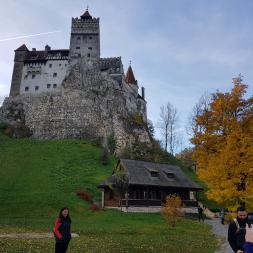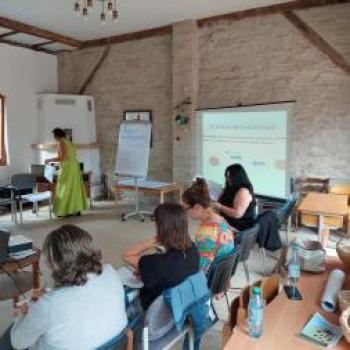
Searching for Dracula – The truth behind the legend
Embark on a captivating 6-day journey through the mystical realms of Dracula, exploring the intersection of myths, legends, and historical realities. This immersive course is designed for educators, school staff, graduates, and enthusiasts eager to unravel the enigma surrounding Count Dracula and his connection to the rich history of Transylvania.
Description
Because Bran Castle is the only castle in all of Transylvania that actually fits Bram Stoker’s description of Dracula’s Castle, it is known throughout the world as Dracula’s Castle.
Dracula – as he is perceived today – is a fictitious character whose name derives from the appellation given to Vlad Tepes, the ruler of Wallachia from 1456-1462 and 1476, and who, for largely political reasons, was depicted by some historians of that time as a blood-thirsty ruthless despot.
Stoker’s character, Count Dracula, first appeared in the novel “Dracula”, published in England in 1897, by the Irish writer Bram Stoker. But the name “Dracula”, far from being a frightening term, derives from the Crusader Order of the Dragon with which Order both Vlad Tepes and his father had been associated. The rest of the Dracula myth derives from the legends and popular beliefs in ghosts and vampires prevalent throughout Transylvania.
Stoker’s Count Dracula is a centuries-old vampire, sorcerer, and Transylvanian nobleman, who claims to be a Székely descended from Attila the Hun. He inhabits a decaying castle in the Carpathian Mountains. In his conversations with the character Jonathan Harker, Dracula reveals himself as intensely proud of his boyar culture with a yearning for memories of his past. Count Dracula appears to have studied the black arts at the Academy of Scholomance in the Carpathian Mountains, near the town of Sibiu (then known as Hermannstadt). While Stoker named his Transylvanian Count “Dracula”, he was careful not to suggest an actual link to the historical character of Vlad Tepes. While Stoker’s character Van Helsing muses as to whether Count Dracula might be the Voivode Dracula, he obviously is not since Count Dracula of Transylvania is plainly not Prince Vlad Tepes of Wallachia and Stoker was disinclined at all to make his character a real person of historic significance.
We are always ready to help you with information about accommodation, transport and anything else.
Learning objectives
Understanding the Real Prince Dracula:
- Gain insights into the historical background and political realities of the time, separating fact from fiction.
- Explore the life of the real Prince Dracula and his significance in Transylvanian history.
Deconstructing the Dracula Myth:
- Examine the myths and legends surrounding Count Dracula, tracing their origins and cultural influences.
- Understand the evolution of Dracula's character in the context of Bram Stoker's novel.
Exploration of Dracula-Related Sites:
- Visit archaeological sites, monuments, museums, and monasteries connected to the real Prince Dracula.
- Gain a deeper understanding of the historical context through immersive experiences.
Educational Programs in Museums:
- Explore educational programs implemented by the Ministry of Education in Romania within museums and archaeological sites.
- Discuss practical guidelines for integrating these activities into the curriculum.
Sharing International Practices:
- Discuss examples of museum and archaeological activities from participants' countries, fostering a cross-cultural exchange of ideas.
- Analyze the effectiveness of various programs in engaging learners and enhancing historical understanding.
Methodology & assessment
Engage in theoretical sessions delving into the historical realities of Prince Dracula, the creation of the Dracula myth, and the political context of the time.
Site Visits:
Undertake guided tours to key locations, including the city center, Sighisoara (Dracula's birthplace), Sibiu History Museum, ASTRA Museum, Bran Castle, and Brasov City.
Immerse yourself in the rich history and architecture of these locations, enhancing your understanding of Dracula's connections.
Group Discussions:
Participate in group discussions to share insights, exchange ideas, and explore different perspectives on the Dracula legend.
Collaborate on theoretical and practical aspects of integrating Dracula-related activities into educational settings.
Practical Workshops:
Implement practical workshops focusing on the development of educational programs that align with curriculum objectives and pupil age and abilities.
Assessment:
Group Work Presentation:
Collaborate on a group project related to Dracula, presenting findings, insights, and proposed educational activities.
Evaluate the effectiveness and creativity of each group's approach.
Tour Assessments:
Assess participants' engagement and comprehension during site visits, gauging the depth of understanding of the historical and cultural context.
Participation and Contribution:
Evaluate active participation, contributions to discussions, and engagement in practical workshops.
Certification details
Course participants will receive a certificate of attendence as well as an Erasmus + mobility certificate.
Pricing, packages and other information
-
Price:580Euro
Additional information
-
Language:English
-
Target audience ISCED:Primary education (ISCED 1)Lower secondary education (ISCED 2)Upper secondary education (ISCED 3)
-
Target audience type:TeacherNot-for-profit / NGO staffOther
-
Learning time:25 hours or more
Past sessions
More courses by this organiser


